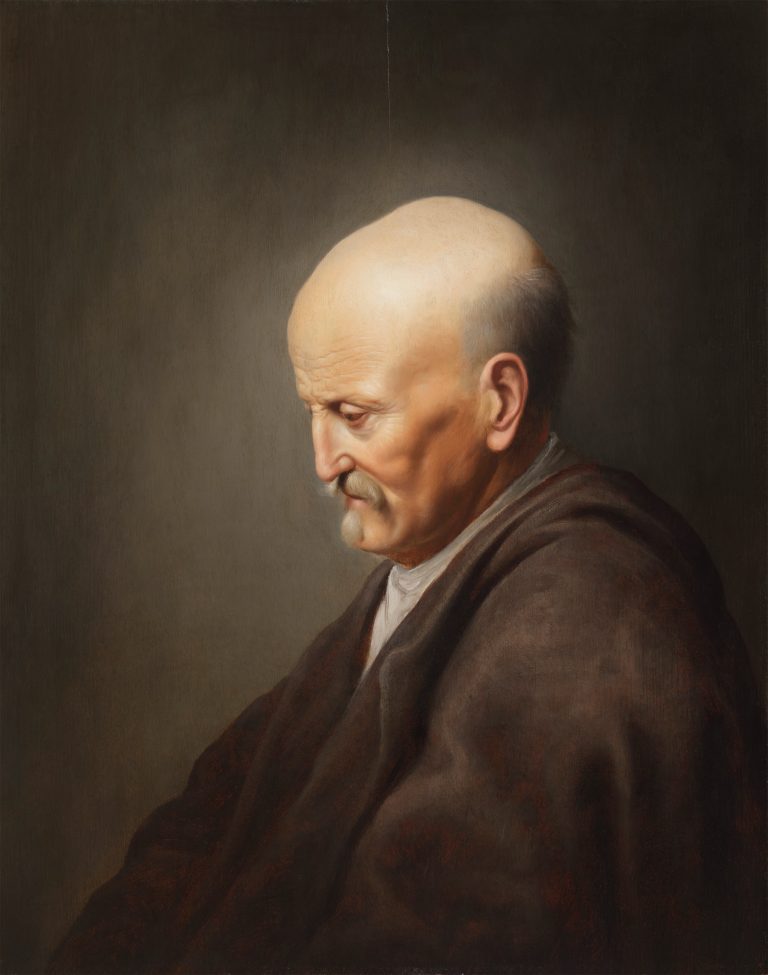Seen in profile, the elderly man seems lost in thought as he gazes quietly downward in a pose echoing the sloped shape of his left shoulder. Intense light reflecting off the sitter’s bald head helps draw attention to his finely rendered and precisely articulated features. No attributes identify the sitter, who wears a softly-rendered reddish-brown woolen cloak that covers a simple white shirt visible at the neck. The painting is, in fact, a character study, or tronie, probably done from life, rather than a commissioned portrait.
In many respects the clarity of modeling in this well-preserved panel painting is similar to that seen in works by Gerrit Dou from the early to mid-1630s. Nevertheless, Dou’s painterly techniques are more nuanced than those evident in this work, as can be seen in a comparison with Dou’s Astronomer (Heraclitus?), ca. 1631–32, in the Hermitage (fig 1), where the same model is depicted. Instead of the blended and smooth brushwork and linear definition of features evident in Elderly Man, in the Hermitage painting Dou used careful parallel hatchings to help enliven the astronomer’s face. Indeed, the glint of light off the sitter’s forehead in Elderly Man is more akin to the reflections off hard, inanimate surfaces in Dou’s Still Life with Globe, Lute, and Books, ca. 1635 (fig 2), than in his images of living individuals.
The model for this tronie, who appears in multiple paintings and etchings by Dou, Jan Lievens (1607–74), and Rembrandt van Rijn (1606–69) around 1630, was well-known in the Leiden artistic community.1 He is, for example, seen in Rembrandt’s etching, Bust of an Old Man, 1630 (fig 3). This man also sat for Lievens, as is evident in that master’s Head of an Old Man, ca. 1629, in the National Gallery of Ireland (fig 4).2 Since the late nineteenth century, this model has often been identified as Rembrandt’s father.3 However, a drawing in the Ashmolean Museum, Oxford (inv. WA1855.11), of a bearded old man bearing the inscription “HARMAN GERRITS” and signed by Rembrandt (“van de Rhijn”), depicts an elderly man whose features clearly differ from those of the sitter in the Leiden Collection work.4
A more likely identification of the model comes from documentation related to another painting in which he appears: Jan Lievens’s Old Man Holding a Skull, ca. 1630 (fig 5). As Lloyd DeWitt has noted, this painting is listed in the 1640 inventory of Jan Jansz. Orlers as “the keeper of the Almshouse with a Skull in his hand” that was “painted from life.”5 Two archival documents reveal that in 1629 and 1631 the financial officer (rentmeester) of the Sint Catharina Gasthuys in Leiden was named Jan van Heussen, who resided in the “Rijn” district of town.6 An engraved portrait Jan van Heussen at the Age of 27 by Hendrick Goltzius, dated ca. 1581 (fig 6), sufficiently resembles the model—including early baldness and the heavy lidded eyes—to suggest that the model for this tronie may have been Jan van Heussen, who would have been seventy-five years old in 1629.7 Regardless of the man’s identity, his distinctive features inspired Rembrandt, Lievens and Dou, and other unidentified artists from Leiden, to repeatedly use him as a model for tronies and in a number of multifigure compositions.8
